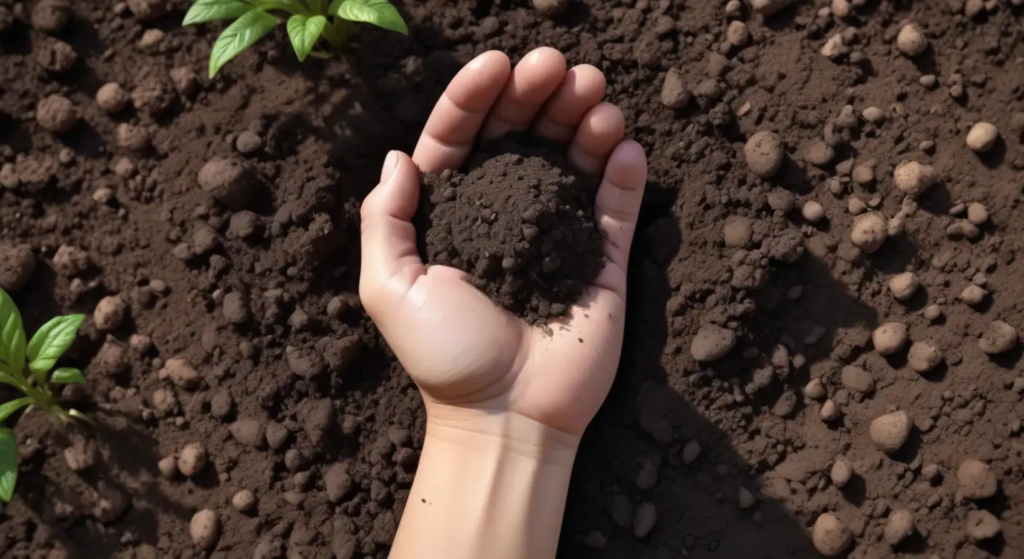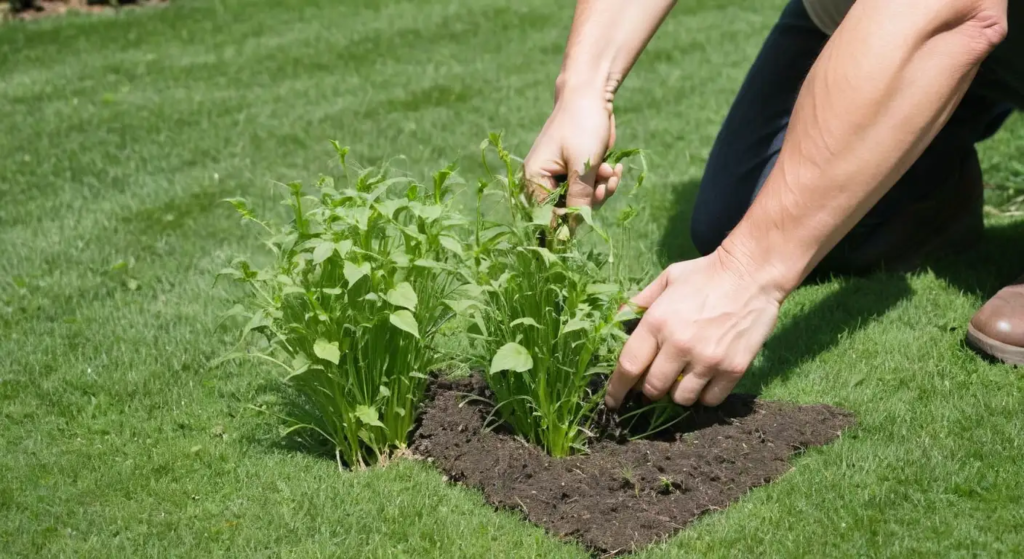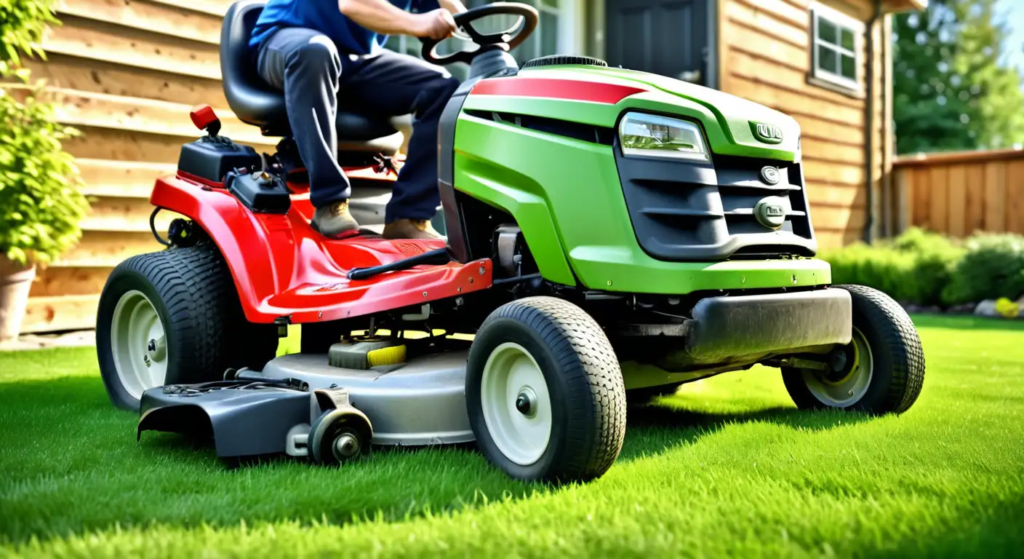With the arrival of spring in Calgary, not only do we welcome the vibrant blooms, but it’s also time to gear up for the lawn care season. As your grass gently rouses from its winter slumber, it’s delicate and in need of careful attention. Feeling overwhelmed? Fear not—Landgraf Lawncare is here with essential spring lawn care tips to ensure your turf transitions smoothly into a season of growth and vitality.

Table of Contents
- Tip 1: Clean Up Your Lawn
- Tip 2: Dethatch
- Tip 3: Aerate If Necessary
- Tip 4: Do A Soil Test
- Tip 5: Control Lawn Weeds
- Tip 6: Overseed Bare Patches
- Tip 7: Fertilize Your Lawn
- Tip 8: Top Off Your Mulch
- Tip 9: Prepare Your Lawn Mower
- Tip 10: Check Your Sprinkler System
- Tip 11: Mow Your Lawn Properly
- Tip 12: Edge Your Lawn
- Tip 13: Water Your Lawn Correctly
- Tip 14: Manage Spring Lawn Pests
Spring Cleaning: Preparing Your Lawn for Growth
Begin the season with a clean slate for your lawn. As Calgary thaws out, you’ll likely find a collection of plant remnants like leaves and twigs scattered across your yard. Equip yourself with a sturdy leaf rake or a powerful leaf blower to tidy up the area. Remember, this organic debris isn’t just waste—it’s a treasure trove for your compost bin, providing you with rich material to nourish your garden, except for any invasive weeds.
When you’re combing through your lawn, be gentle but thorough. If you encounter patches of grass that have clumped together, it’s time to intervene. These mats, often a result of snow mold, overwatering, or dense soil, can hinder the growth of fresh grass. However, be cautious not to include any grass that shows signs of disease in your compost.
In the wetter days of spring, if the ground is still soft from recent rains, hold off on the raking. Disturbing soggy soil could accidentally uproot the healthy grass you want to keep. With these mindful practices, Landgraf Lawncare ensures your Calgary lawn is primed for a vibrant season ahead.
Thatch Management: Ensuring a Healthy Lawn Foundation

Thatch, the layer of both living and decomposed plant material nestled between your grass and the soil, serves as a natural blanket for your turf in Calgary. A thin layer is beneficial, but when it exceeds ½ inch, it can impede water, nutrients, and air from reaching the soil, leading to a distressed lawn. To maintain the health of your lawn, Landgraf Lawncare recommends periodic dethatching for optimal grass growth.
Assessing Thatch Thickness: To determine if your lawn requires dethatching, take a 3-inch-deep soil sample and measure the thatch layer. If it’s thicker than ½ inch, it’s time for action.
Timing Your Dethatching: The best time to dethatch is during your grass’s peak growing period:
- For warm-season grasses like Zoysia and Bermuda, late spring is ideal.
- For cool-season varieties such as fescues and Kentucky bluegrass, aim for early spring or fall.
Dethatching Methods: You can tackle thatch with a specialized dethatching rake, a power dethatcher, or a verticutter. Some thatch may have already been removed during your initial spring clean-up with raking.
For those who prefer a professional touch to ensure the job is done right, Landgraf Lawncare offers expert dethatching services tailored to the unique needs of Calgary’s diverse lawn landscapes. Let us help you lay the groundwork for a lush, vibrant lawn this season.
Aeration Essentials: Breathing Life into Your Lawn

In Calgary’s diverse climate, ensuring your lawn has the right conditions to thrive is crucial. Aeration, the process of perforating the soil, can be a vital step in revitalizing your lawn. It allows oxygen, water, and nutrients to penetrate the turf roots, which helps the grass grow lush and strong.
When to Consider Aeration: Aeration is particularly beneficial for lawns with compacted soil or those composed of heavy clay. It’s also recommended if your lawn endures high foot traffic, which can lead to compaction. Signs that your lawn may need aeration include water pooling after rain or difficulty penetrating the soil with a screwdriver.
Timing for Aeration: Align aeration with your grass type’s growing season for optimal recovery:
- Warm-season grasses: Aerate in late spring as they enter their growth spurt.
- Cool-season grasses: Early spring or fall is the best time for aeration.
DIY or Professional Aeration: You can aerate your lawn yourself using a manual aerator or rent a machine for larger areas. However, for guaranteed results and to ensure the best care for your lawn, consider enlisting the professional services of Landgraf Lawncare. Our team is equipped to provide thorough aeration, setting the stage for a robust and healthy lawn throughout the seasons in Calgary.
Soil Testing: The Key to a Balanced Lawn

Ensuring that your lawn in Calgary has the ideal soil conditions is essential for healthy grass growth. Most turfgrasses flourish in neutral pH levels, typically between 6 to 7. Signs like the presence of moss or certain weeds can indicate acidity, while plants such as clovers may suggest alkalinity. However, these signs are just clues, and a proper soil test will provide a definitive assessment of your soil’s pH and nutrient profile.
Conducting a Soil Test: A soil test will give you a comprehensive view of what your soil may be lacking or have in excess. It measures pH levels and key nutrients like nitrogen, phosphorus, and potassium, which are crucial for plant health.
Interpreting Soil Test Results: If the test indicates that your soil is too acidic (pH < 6) or too alkaline (pH > 7), you’ll need to adjust it accordingly. For instance, applying lime can help raise the pH of overly acidic soil.
Landgraf Lawncare can assist you with conducting a thorough soil test and interpreting the results. We’ll guide you on the necessary amendments to achieve the perfect balance for a lush, green lawn that’s the envy of Calgary. Let’s get testing and tailor your lawn care to the exact needs of your soil!
Certainly! Here’s the revised section without the product review part:
Weed Warfare: Strategic Control for a Pristine Lawn

Effective weed management is a two-pronged strategy: prevention and reaction. For Landgraf Lawncare in Calgary, this means deploying pre-emergent herbicides at the start of the season to stop common weeds like crabgrass and purslane before they can take root. Timing is crucial; apply too early and you miss the weeds, too late and they’ve already claimed territory. It’s also important to note that pre-emergents can disrupt the growth of new grass seeds, so caution is advised during overseeding.
For those pesky weeds that slip through the cracks, post-emergent herbicides come into play. Targeting already-sprouted weeds, spot-treatment is the most efficient and cost-effective method, preserving your lawn’s overall health. While hand-pulling and smothering are alternatives, they may fall short against stubborn perennials like dandelions and ground ivy.
For those who prefer a homemade touch, we can guide you in creating effective natural weed killers. And if DIY isn’t your style, our professional team at Landgraf Lawncare is ready to step in and ensure your Calgary lawn remains immaculate and weed-free. Let’s keep your lawn looking its best with strategic weed control tailored to your needs.
Revitalizing Your Lawn: The Art of Overseeding

A lush, full lawn is a point of pride for homeowners, and Landgraf Lawncare understands the challenges that Calgary’s climate can pose. Overseeding is a critical technique in repairing a lawn that’s been worn down by foot traffic, environmental stress, or other damaging factors. It involves sowing new grass seeds directly into existing turf without tearing up the soil or grass.
Optimal Timing for Overseeding: The timing for overseeding is contingent on the type of grass and local climate conditions:
- Warm-season grasses: such as Zoysia and Bermuda, should be overseeded in late spring when they’re actively growing.
- Cool-season grasses: like fescues and Kentucky bluegrass, are best overseeded in the fall. However, if your lawn is particularly sparse, an early spring overseeding can be beneficial.
Preparation Before Overseeding: If dethatching or aeration is on your spring lawn care agenda, make sure to complete these tasks before overseeding. This ensures that the new seeds have the best chance to embed in the soil and germinate successfully.
Caring for New Seeds: Just like new seedlings, overseeded areas require consistent moisture to establish themselves. Watering schedules will vary based on weather conditions and soil type, but the goal is to keep the top inch of soil consistently moist without over-saturating.
With Landgraf Lawncare’s expertise, your Calgary lawn will regain its vitality and enhance your home’s curb appeal. Ready to transform your lawn? Let’s get started on the path to a greener tomorrow.
Nourishing Your Turf: Fertilization Fundamentals
A vibrant lawn is a sign of a healthy outdoor space, and at Landgraf Lawncare, we understand the importance of providing your turf in Calgary with the essential nutrients it needs. Fertilizers containing nitrogen (N), phosphorus (P), and potassium (K) are key to a thriving lawn. However, moderation is crucial—over-fertilization can lead to weak, overgrown grass.
Steps for Effective Fertilization:
- Soil Testing: Begin with a soil test to determine the nutrient levels and the appropriate N-P-K ratio for your lawn.
- Measuring Your Lawn: Calculate the area of your lawn in square feet by dividing it into basic shapes and summing up the total area.
- Fertilizer Calculation: Aim to apply 1 pound of nitrogen for every 1,000 square feet. Use the N value from the fertilizer’s N-P-K ratio, convert it to a decimal, and divide by 1 to find out how many pounds of fertilizer are needed per 1,000 square feet.
- Weather Check: Avoid fertilizing if rain is expected within two days, or if the grass is wet. For liquid fertilizers, avoid application on windy days.
- Safety First: Always wear protective gear such as gloves, goggles, and a mask to prevent burns from nitrogen.
- Read Instructions: Follow any specific instructions or restrictions provided with the fertilizer.
- Application Technique: Spread the fertilizer evenly, starting from the perimeter and moving inwards in a grid pattern.
- Clean-Up: Use a leaf blower or broom to push any excess fertilizer back onto the grass.
- Post-Application Care: Watering may be necessary after application, depending on the type of fertilizer used.
Timing Your Fertilization:
- Fertilize about three weeks after your grass shows signs of growth in the spring.
- If you’ve applied herbicides, wait at least a week before fertilizing.
Watering Before Fertilizing:
- Water your lawn a few days prior to fertilization.
- Apply the fertilizer lightly to avoid the risk of fertilizer burn.
With these guidelines, Landgraf Lawncare ensures that your lawn receives just the right amount of care to flourish throughout the season. Ready for a lush, green lawn? Let’s make it happen!
Mulching Mastery: Protecting and Enriching Your Lawn

Mulching is a critical component of maintaining a healthy lawn and garden in Calgary. By adding a layer of mulch, you’re not only safeguarding your soil against compaction and invasive weeds but also enhancing its fertility. Early to mid-spring is the ideal time to apply or replenish mulch, aiming for a depth of 2 to 3 inches.
Organic Mulches: Nature’s Nutrient Providers Organic mulches are a dual-purpose solution. They protect your soil while gradually decomposing and enriching it with valuable nutrients. An added benefit is that many organic mulches can be sourced for free, right from your yard. Grass clippings, for instance, are an excellent choice for mulching.
Here’s a list of organic and inorganic mulch options for Landgraf Lawncare:
Organic Options:
- Leaves
- Tree bark
- Grass clippings
- Pine needles
- Wood chips
- Aged sawdust
- Straw
Inorganic Options:
- Rocks and gravel
- Landscape tarp
- Landscape fabric
- Metallic mulch
- Rubber mulch
Choosing the right mulch depends on your specific lawn needs and aesthetic preferences. Organic mulches will enhance soil health over time, while inorganic mulches are more durable and require less frequent replacement. Whichever you choose, Landgraf Lawncare is here to help you apply it perfectly, ensuring your Calgary lawn remains protected and productive. Let’s get mulching and give your lawn the care it deserves!
Pre-Mowing Tune-Up: Lawn Mower Maintenance

As the mowing season approaches in Calgary, ensuring your lawn mower is in top condition is essential for Landgraf Lawncare. Here’s a comprehensive guide to preparing your mower for spring:
- Warm-Up: Before starting, let your mower bask in the sun for about an hour to ease the start-up process.
- Initial Start-Up: Fire up the mower to identify any starting issues. If it struggles, it’s time for a tune-up.
- Tune-Up Tasks:
- Gas-Powered Mowers: Replace the oil, spark plug, and air filters. Then, refill the fuel tank.
- Battery-Powered Mowers: Inspect the battery and replace it if it no longer holds a full charge.
- Blade Care: Sharpen the blades for a clean cut, crucial for healthy grass. Replace the blade if it’s too worn or damaged.
- Deck Cleaning: Clear out grass clippings, dirt, and debris from under the deck with a water rinse.
Maintaining Other Lawn Care Tools:
- Lawn Edger: Clean off any dirt and inspect the engine belts, head, oil, fuel/battery, and air filter. Replace parts as necessary and sharpen the blade if dull.
- String Trimmer: Clean, check the oil, fuel/battery, and air filter, and replace the trimmer line.
- Cutting Tools: Keep the blades sharp for efficient cutting.
By following these maintenance practices, Landgraf Lawncare also uses these to ensure that all equipment is ready to keep Calgary lawns looking their best. Ready to start the season with well-maintained tools? Let’s get to work!
Sprinkler System Spring Check-Up

Ensuring your sprinkler system is functioning correctly after the winter freeze is crucial for maintaining a healthy lawn. Here’s a step-by-step guide to get your sprinklers ready for spring:
- Clean Your Sprinklers: Start by cleaning each sprinkler head to remove any clogs caused by debris. A simple brush or rinse can often do the trick, ensuring that water flow isn’t obstructed.
- Adjust Sprinkler Heads: Inspect the direction of each sprinkler head. If they’re not aligned properly, use an adjustment screw to correct their orientation. The process may vary slightly depending on your system’s model.
- Monitor for Malfunctions: Run your sprinkler system and observe. Look out for erratic water streams, excessive runoff, or puddles, which could indicate leaks or damage. No water output might signal a more systemic issue.
- Conduct Repairs: Address any problems you’ve identified. Simple fixes can often be DIY, but for more complex issues or if you’re unsure, it’s wise to call in a professional.
Mowing Mastery: Keeping Your Calgary Lawn in Top Shape

Mowing your lawn is more than just cutting grass; it’s about maintaining the health and appearance of your turf. Here are some mowing tips to ensure your lawn stays lush and vibrant:
- Trim Wisely: Remove only one-third of the grass blade length at a time to avoid stressing the grass.
- Height Matters: Wait until your grass is 50% taller than the ideal height before mowing. Aim to cut down to the ideal height, but err on the higher side to suppress weeds.
- Avoid Wet Mowing: Wet grass can lead to mower clogs and uneven cuts.
- Vary Your Pattern: Change your mowing pattern each time to prevent grass from leaning and creating ruts.
- Overlap Slightly: Ensure an even cut by overlapping mowing paths slightly.
- Ease Into the Season: Start with bi-weekly mowing and shift to weekly as growth accelerates with warmer weather.
- Mind the Heat: Mow in the cooler mid-morning or late afternoon to avoid heat stress on your lawn and yourself.
Here’s a handy reference for the ideal mowing heights for different grass types found in Calgary:
| Grass Type | Ideal Height (inches) | Mow At This Height (inches) |
|---|---|---|
| Kentucky Bluegrass | 2 – 3 | 2.5 – 4 |
| Perennial Ryegrass | 2 – 3 | 2.5 – 4 |
| Creeping Red Fescue | 2.5 – 3.5 | 3.25 – 4.5 |
By following these guidelines, you’ll ensure that Landgraf Lawncare keeps Calgary lawns looking their absolute best. Ready to start mowing? Let’s cut to the chase
Perfect Edges: Enhancing Your Lawn’s Appeal

Spring indeed offers the ideal conditions for edging your lawn in Calgary. The softer soil makes it easier to create those sharp, defining lines that give your lawn a manicured appearance. Here’s how to achieve that perfect edge:
- Choose Your Tool: A manual landscape edger or a motorized lawn edger will be your primary tools for cutting clean edges.
- Create the Edge: Use your chosen tool to carve out a distinct boundary between your lawn and adjacent surfaces like sidewalks, driveways, or garden beds.
- Add Definition: For added stability and style, consider lining your new edge with materials like metal, wood, stone, or brick.
As the growing season progresses, maintain your lawn’s edges with a string trimmer. This will keep them looking neat and prevent grass from encroaching on your clean lines.
Edging is more than just aesthetics; it helps prevent the spread of grass into unwanted areas and makes for a healthier lawn. Landgraf Lawncare is ready to bring that professional touch to your property’s springtime look. Let’s edge your way to a pristine lawn!
Smart Watering: Hydrating Your Lawn Efficiently

Proper irrigation is vital for a healthy lawn, and understanding the balance between too little and too much water is key. Here are some tailored tips for watering your lawn in Calgary:
- Optimal Timing: Water your lawn during the early morning hours, between 5 a.m. and 9 a.m., to minimize evaporation and wind interference.
- Thirst Test: Check your lawn’s hydration by stepping on the grass; if it doesn’t spring back up, it’s time to water.
- Spring Watering: In early spring, water less frequently due to cooler temperatures and potential rainfall contributing to soil moisture.
- Seasonal Needs: Cool-season grasses typically require 1 to 1.5 inches of water per week in spring, while warm-season grasses need about 1 inch.
To ensure your sprinkler system is delivering the right amount of water, conduct the tuna can test:
- Distribute empty tuna cans across your lawn.
- Run your sprinklers for 15 minutes.
- Measure the water depth in each can with a ruler and calculate the average.
Based on the average depth, use this table to determine the necessary sprinkler runtime to deliver 1 inch of water:
| Average Depth After 15 Minutes | Total Minutes to Water 1 Inch |
|---|---|
| 1/8 inch | 120 minutes |
| 1/4 inch | 60 minutes |
| 1/2 inch | 30 minutes |
| 3/4 inch | 20 minutes |
| 1 inch | 15 minutes |
By following these guidelines, you’ll ensure that Landgraf Lawncare provides just the right amount of water to keep your lawn in Calgary healthy and thriving. Ready to optimize your lawn’s hydration? Let’s get watering!
Spring Pest Vigilance: Protecting Your Lawn
As the warmth of spring sets in, it’s crucial to be vigilant about lawn pests that can undermine the health of your turf. Common culprits like sod webworms, ticks, and aphids emerge, but grubs are particularly notorious for appearing in late spring and can cause significant damage if left unchecked.
Integrated Pest Management (IPM): This approach combines various strategies to manage pests effectively and sustainably. It involves monitoring pest populations, understanding their life cycles, and employing a combination of cultural, physical, biological, and chemical control methods when necessary.
Organic Pest Control: For those seeking environmentally friendly options, organic pest control utilizes natural predators, neem oil, diatomaceous earth, and other non-synthetic means to combat pests.
If you’re facing a persistent pest problem, it may be wise to consult with a professional. They can offer tailored solutions to protect your lawn from these springtime invaders.
Landgraf Lawncare is committed to keeping your Calgary lawn pest-free with careful monitoring and appropriate interventions. Let’s ensure your lawn remains a thriving, pest-resistant oasis!
Spring’s cool weather and frequent showers indeed create a conducive environment for various lawn fungal diseases. Here’s a brief overview of the diseases you mentioned and how to manage them:
- Fairy Ring: Manifests as dark green circles or arcs in the lawn, sometimes accompanied by mushrooms. Aeration and proper watering can help manage this condition.
- Necrotic Ring Spot: Appears as rings or patches of dead grass. Reducing soil compaction through aeration and improving drainage can help control it.
- Dollar Spot: Identified by small, round, sunken patches. Maintaining balanced nitrogen levels and morning watering can reduce the risk.
- Snow Molds: These become visible as the snow melts, showing up as circular patches of matted grass. Raking and improving air circulation can help prevent it.
- Anthracnose: Causes irregular brown patches. Ensuring good air circulation and avoiding excess nitrogen can help manage this disease.
- Leaf Spot and Melting-Out: Leads to small, dark spots on grass blades, progressing to larger patches of dead grass. Proper fertilization and watering practices are key to prevention.
- Rust: Recognizable by the orange or yellowish powder on grass blades. Watering deeply but infrequently and removing thatch can help control rust.
Good lawn management practices are indeed your first line of defense against these diseases. This includes proper watering, mowing at the correct height, aeration, and balanced fertilization. If your lawn becomes diseased, applying an appropriate fungicide, either by yourself or with the help of a professional, can effectively treat the fungal issue.




Undeniably believe that which you stated.
Your favorite reaswon seemed to be on the internet the simplest thing too be aware of.
I say to you, I definitely get irked while people thonk about worries that
they just do not know about. You managed to hit the nail upon the top as wll as defined oout the whole thing without having side-effects , people can take a signal.
Will probably be ack to get more. Thanks